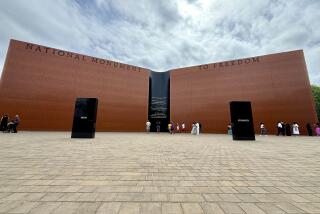‘Bloody Sunday’ bridge in Alabama among new national landmarks
WASHINGTON - An Alabama bridge that was the site of the “Bloody Sunday” civil rights march, an Oklahoma battlefield where “Native Americans fought as members of both Union and Confederate armies,” and a Kentucky distillery that operated before, during and after Prohibition are among the latest national historic landmarks.
Interior Secretary Ken Salazar on Monday announced the addition of 13 sites to a list of 2,540 landmarks, declaring that the largely honorary designations will “help tell the story of America.”
Among the new landmarks is the Edmund Pettus Bridge in Selma, Ala., where on March 7, 1965, law enforcement officers beat civil rights marchers. Outrage over the violence helped create a groundswell for passage of the 1965 Voting Rights Act.
The landmarks are “nationally significant historic places” designated by the Interior secretary “because they possess exceptional value or quality in illustrating or interpreting the heritage of the United States,” the National Park Service said.
Other new landmarks include:
-- George T. Stagg Distillery in Kentucky. “It provides an unparalleled opportunity to study at one site the evolution of buildings and technology associated with the American whiskey industry,” the Interior Department said.
-- Hinchliffe Stadium in New Jersey. The stadium is an example of a Negro League baseball stadium in 20th century segregated America.
-- Honey Springs Battlefield in Oklahoma. This was the site of “the largest Civil War engagement of the 1861-65 period of conflict within Indian Territory,” the department said. “It is also significant as the first and largest engagement in which Indian troops of both sides fought in the formalized style of Anglo-American warfare.”
-- Old San Juan Historic District/Distrito Histórico del Viejo San Juan in Puerto Rico. This portion of the city is “the only existing representation of an almost 400-year-old Spanish colonial city in the United States,” according to the department.
-- Camp Nelson Historic and Archeological District. The site in Kentucky is described as one of the nation’s largest recruitment and training centers for African American soldiers during the Civil War.
-- The Hartford, Conn., home of abolitionist and author Harriet Beecher Stowe. The home is associated with her later career as a reformer on issues relating to the family and women.
-- Yaddo in Saratoga Springs, N.Y. The site is described as “one of the country’s oldest artists’ retreats.” Yaddo has hosted more than 6,000 influential writers, visual artists and composers who “shaped and imprinted American culture with a distinct national identity in the 20th century,” the Interior Department said.
ALSO:
Jury convicts ex-Detroit Mayor Kwame Kilpatrick
House fire in Kentucky kills 7, including 5 children
UNLV’s ‘Hey Reb’ mascot is hanging up his big head
More to Read
Sign up for Essential California
The most important California stories and recommendations in your inbox every morning.
You may occasionally receive promotional content from the Los Angeles Times.











